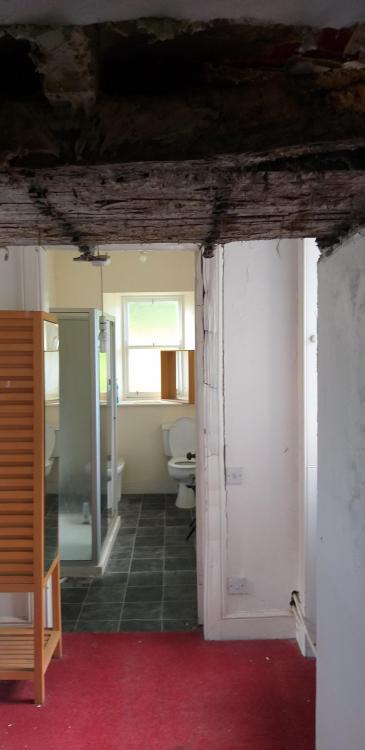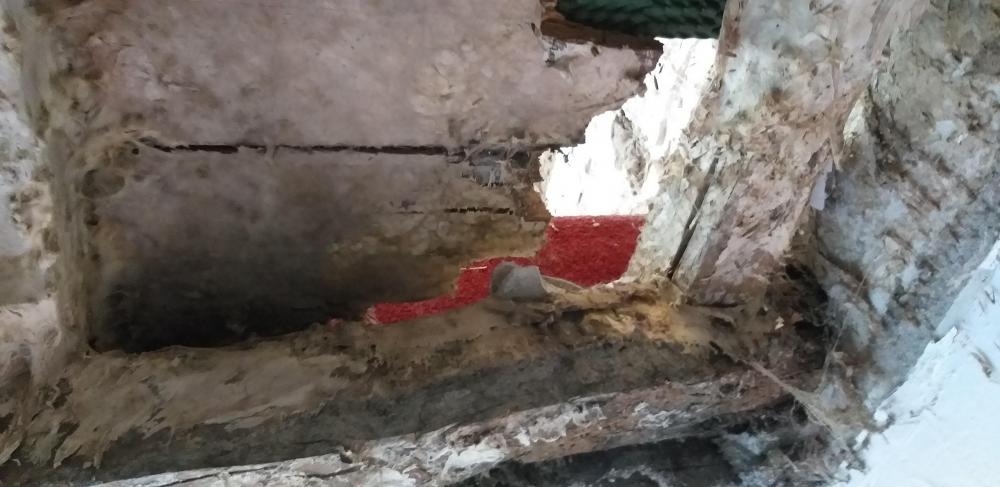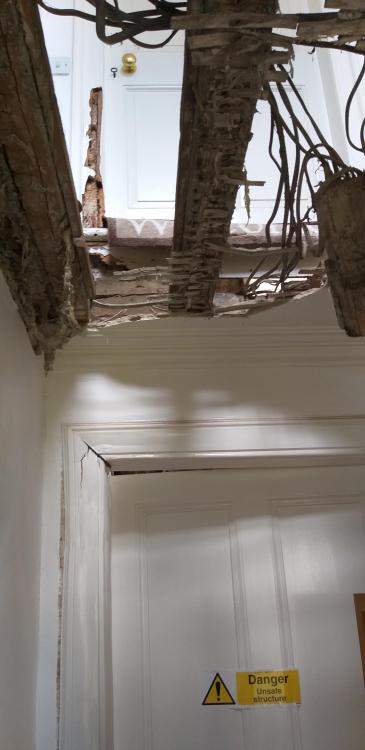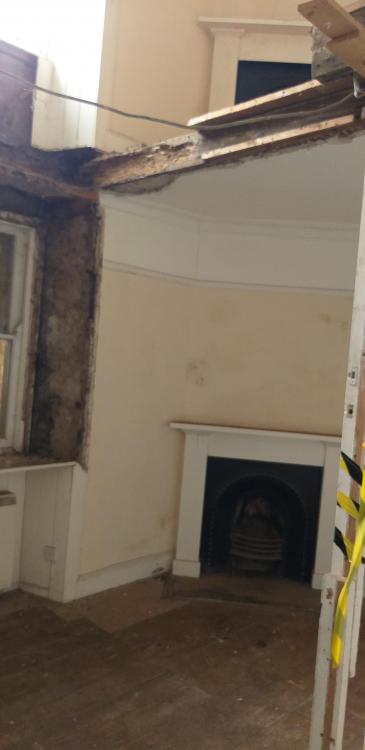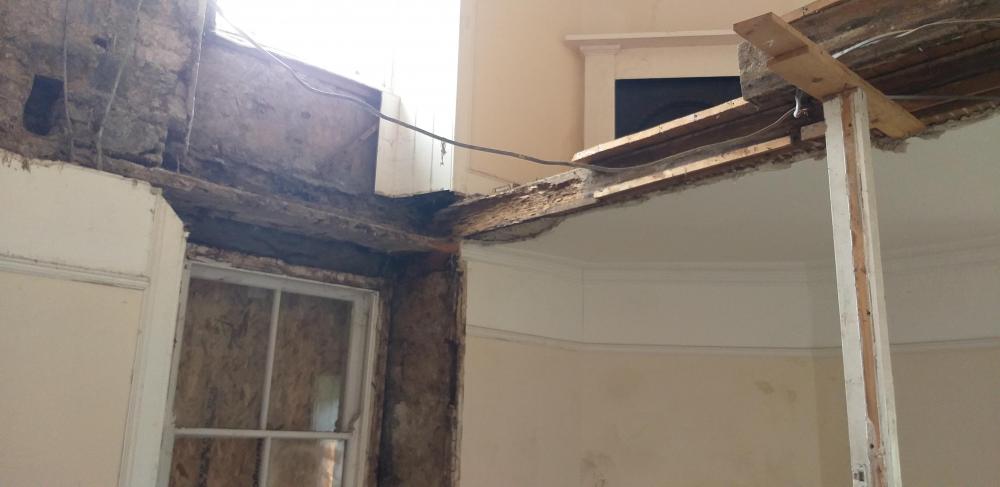
Imogen
Members-
Posts
9 -
Joined
-
Last visited
Recent Profile Visitors
The recent visitors block is disabled and is not being shown to other users.
Imogen's Achievements

New Member (2/5)
2
Reputation
-
Hello ? No chance of lodger until it's finished. I only have one room that's "safe-ish" to live in and access is via a severely decayed staircase. The dry rot quote followed a day of exposure works so they have a good idea of what's needed. The quote includes a plan diagram. They are taking out almost all of the floors, internal walls, ceilings and about 70% of the windows. Then strip all plasterwork and treat stonework. New concrete screed and floating floor to downstairs rear elevation. Upstairs needs new joists/floorboards on most of the 1st and 2nd floor (attic). Replace almost all the ceilings and internal walls (finished with plaster skim). Replace listed Georgian staircase (will need to be custom made due to size & unusual proportions). Replace rotten lintels and original door frames then treat and rehang doors. Replace original sash windows (8 of these, 5ft high, 4ft wide) and the original shutters and original panelling on each one. Oh and install couple of large RSJs to replace rotten timber beams. Biggest costs are the joinery jobs -custom staircase and the windows/window shutters/panelling. The house is listed because the joinery is all original so IMO it's essential it goes back as it is. This will all be done with treated timber and have a 25yr insurance backed guarantee from a PCA firm. There is a possibility that two more windows will need replacing depending on inspection. They said allow 3% contingency.
-
It's 194m2 internal, 258 external excluding outbuilding. Built late 1700s. I have sassins (sp?) from 1795 so some time before that. Grade B listed (Scottish equivalent of English II*) but head conservation officer said she thought it she be a 'C' (grade II) really and that the dry rot works would be considered a repair rather than alteration as the timbers are being reinstated exactly as is. Property is 2 storey but with one room in the attic. There's also a single storey stone outbuilding (stable?) attached which is the size of a small cottage. I had intended to convert it at a later date.
-
1st pic is door to the bathroom. You can see the rot is literally knocking on the door. I am going for the "open plan" look, as you can see ???
-
Have I got this wrong Ferdinand? I had assumed that because of the serious structural issues caused by the dry rot (e.g rooms where 50% of the floor has been removed and internal walls/ceilings taken down) that no normal bank would offer a mortgage. The house does have two basic bathrooms (1st floor one inaccessible due to the collapsing staircase but fully plumbed in). Ground floor bathroom is still accessible (although hallway leading to it is severely affected and perilous). It has an electric shower which is working and a working loo. I did spend some money on heating. I have installed an 8kw multifuel stove in the room I live in. I have also partially installed a central heating system. There is an oil fired Rayburn cooker (purchased 2nd hand by me) which provides cooking facilities and powers a brand new hot water tank and several radiators which are installed on one side of the house. The plan had been to install rads to the other side once dry rot treated but we then discovered the spread was extensive and covered the entire house. The heating system currently switched off due to the condition of the building. I think this will all have to be ripped out when the rot is treated, though I will ne able to reuse most of it.
-
Thank you for your words of encouragement. I was very down/hopeless yesterday which probably came across in my post. The "nightmare" is being stuck unable to move forwards and repair the house. If I can find a way to fix the dry rot, my choice would be to stay every time. Not interested in making money from the house, I didn't buy it with that in mind. I wanted a home to live in for the next 50 years. I do have one debt. A low interest (2%) personal loan with my bank (£215 pm) which was for a car (I travel 50 miles a day for work so essential). Have run affordability calculators for several mortgage providers and they still come out ok. I was just debating whether in terms of securing a renovation mortgage, should I be paying that loan off over the next 18 months or attempting to save a deposit?
-
Thabk you so much. Your post has been so helpful Ferdinand. I am afraid I was the idiot who fell in love and bought the house! It had already gone to auction twice at £120k and not sold. I then offered £80k and they took it to auction a third time to try to get a better deal. Needless to say nobody else was smitten with the decrepit ruin so it was mine. I didn't buy the house to make money and had never intended to sell it. I wanted to be its custodian (previous family had done no modernisation in about 70 years). Even derelict, it was my dream home and I was prepared to live through a decade of hardship to achieve it. I have done three Scottish winters with no heating. I was planning to die in this house - though perhaps not throught death by collapsing staircases or chunks of lath plaster ceilings ?
-
The dry rot firm advised me that I should strong consider sueing the building surveyor as the spread should've been obvious (e.g. stairs were crumbling on the day I took the keys bit survey missed it) but I showed the report to a good friend who is a contract solicitor not long after I bought the house in 2017 and she said there's a lot of caveats/disclaimers in it to protect him from future claims. She thought chances of success were slim. My mistake was asking a building surveyor to assess the works needed on the property rather than going straight to a dry rot firm.
-
Thank you so much for the replies. I can't really put into wordshow grateful I am, even if there's not much anyone can do. Selling is out of the question. The house was on the market for years before I bought it at a knock down rate. From local knowledge, nobody will touch it in this state. Most builders correctly guessed essential repairs would be £100k plus. Shame the surveyor didn't! I live in a rural area where GOOD tradesmen are thin on the ground. Those with listed building expertise are like hen's teeth. I have had the council's conservation officer and building chief out to visit and advise. The dry rot firm (national company) who quoted are in the words of the building chief "the only firm he would let near a listed building restoration of this scale". He recommended them personally (council's main contractor) and strongly advised me against letting any local firms have a go as they would be out of their depth. They're also the only firm in the county able to provide a proper insurance backed guaranted. I've already approached Historic Scotland sadly. They don't offer grants to home owners in my situation anymore. Property is not insurable as it is. I did try to insure it as soon as I purchased but was advised it wasn't insurable because the roof was actively letting water in and that I would need renovation insurance. So I prioritised replacing the roof in order to get insurance then rang several firms but was advised they couldn't insure as in fixing the roof, the renovation had already started! Unfortunately yes, am stuck living in it. One room plus a basic kitchen. Can't remain here much longer now due to deteriorating condition internally (staircase now precarious). Has also made me very ill two winters in a row. Without being able to finance at least the £120k I need for the dry rot works, I don't have any options. Family don't have cash to lend.
-
Hi all! ? 1st post here so please be gentle. I have got myself into a nightmare with a renovation and am hoping for some financial advice on how to get out. If anyone can suggest any Scottish brokers with the right expertise that'd be great. I bought a large listed building in 2017 for £80,000 in cash, which needed dry rot repairs. The home report value AFTER repairs was given as £230,000. With full renovation end value high 200s. I had a survey from listed building expert which erroneously indicated the dry rot was confined to one side. I bought the house outright and spent circa £30k on a new roof and on urgent structural repairs (collapsing chimneys etc). Plus other urgent work making £120k total. Soon emerged dry rot spread was EXTENSIVE (roof also needed full replacement not patch repair). Builders literally laughed at the survey. I was in over my head & renovating without a mortgage wouldn't work. August 2019 I had a dry rot contractor determine spread and repair costs. They quoted just under £100k plus VAT to replace virtually all the timbers - floors, ceilings, walls, stairs and windows. Time frame given is 3-4 months then I'd need to reinstate the heating, electrics and bathrooms. Need to find £140-160k finance. As I have now spent all my savings getting the building dry. I have no deposit. The only security I have is the building! Full time employment (teacher) earning £41k gross. Is there ANYTHING I can do to get the dry rot works started and get out of this mess? Is there anyone professional I can approach? I tried Buildstore but got no response, which doesn't bode well.

